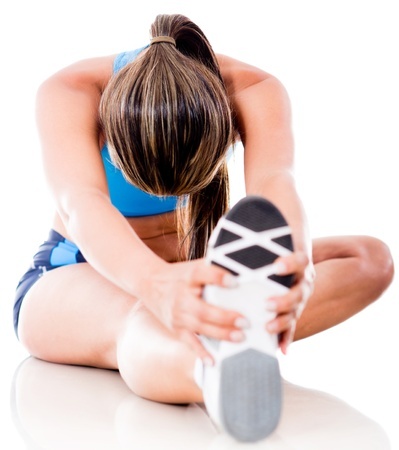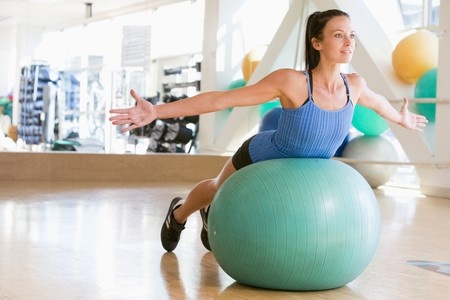“Two thirds of health care costs are driven by our daily choices – WE are in the driver’s seat.†– Institute of Medicine, 2006
Welcome back to the third and final post of my celebration of Exercise is Medicine Month! Last week, I talked about Strength Training exercise. If you missed it, you can read about it here. This week, I’ll plunge into the final aspects of a well-rounded fitness routine…
Flexibility
 The third component of your fitness routine is flexibility and it’s typically the component that many folks skip. Flexibility is the ease with which you can move your joints through a full range of motion. The way to stay flexible or to increase your flexibility is by stretching.
The third component of your fitness routine is flexibility and it’s typically the component that many folks skip. Flexibility is the ease with which you can move your joints through a full range of motion. The way to stay flexible or to increase your flexibility is by stretching.
Women often ask me why we don’t stretch to warm-up prior to lifting weights. The answer is because, contrary to popular belief, stretching is NOT a warm-up activity! A warm-up activity might be walking for a few minutes prior to your run or weight training routine. Stretching should be done AFTER the muscles are warm, usually at the conclusion of your workout.
A good stretching routine consists of stretches for each major muscle group. You want to hold each stretch, without bouncing or movement, for 20-30 seconds. A full post-exercise stretching routine only takes around 10 minutes to complete. The book, Stretching, by Bob Anderson shows wonderful stretching routines for everyday, as well as for specific sports or activities. I can’t recommend this book enough!
Yoga is another excellent way to increase your flexibility, not to mention decrease stress and aid in mindfulness and presence. There are many books and DVDs available, as well as classes in most locales.
And, last, but certainly not least…
Neuromuscular or Functional Training
Neuromuscular or Functional Training is fast becoming the trendy new thang in the fitness industry, though it’s been around for many years in the physical therapy and sports realms.
In the words of the strength training legend, Tudor Bompa: “Train movements, not muscles.†And, that’s what functional training is all about.
For us “normal†folks, functional training is based on tasks directed toward everyday life activities, which emphasize using the full range of motion of the joints of the body, core stability and balance work. This type of exercise is valuable, especially as we age, allowing us to continue our active lifestyles and avoid falls.
When we perform strength training using a machine – Cybex, Nautilus, for example – we train mostly the targeted muscle or prime mover in a very specific and restricted range of motion. The need and movement of the helper muscles or synergistic muscles is limited.
So?
Well, I hear from women all the time that they’ve been told that machines are safer to use, especially for beginners. I disagree. Though machines seem to be safer, the restricted movements are unnatural and open up the potential for incorrect movement patterns or injury.
What’s safe is to allow the body to move freely, performing exercises within only the confines of each woman’s range of motion, taking into consideration old injuries, different levels of flexibility or simply the limitation of individual physical idiosyncrasies. Another benefit to functional training is that the synergistic/helper/stabilizer muscles are put to work, so that ALL the muscles in the body are used – the same way that they are in real life.
Think about it – we typically don’t just do a simple squat in real life. No, we squat down in front of the cabinet and then we practically bend ourselves into the cabinet to reach that rarely-used baking dish WAY in the back. We get up on our tiptoes, we reach, we bend, we trip over the edge of the rug and lose our balance, we regain our balance, we push, we pull, we lift… We use so many more muscles in real life than in the gym on a machine.
Functional training recognizes this fact and the equipment is designed to strengthen the muscles in all planes of movement. Some equipment that is used for functional training are things like balance balls, cable machines (The Total Gym is a GREAT functional training piece of equipment, by the way), dumbbells, medicine balls, kettle bells, body weight – anything that allows the body to move freely and/or places it in an unstable environment.
 For years, I’ve been using the functional training philosophy exclusively with my clients – even beginners. I put them on a stability ball – an unstable surface – using the “free-est†free weights there are – dumbbells – and have them do strength training exercises.
For years, I’ve been using the functional training philosophy exclusively with my clients – even beginners. I put them on a stability ball – an unstable surface – using the “free-est†free weights there are – dumbbells – and have them do strength training exercises.
What!?Â
Yep. For a couple of weeks, they’re wobbly and unsure (I’m there to spot, of course). And, then, like magic, the nerves begin to fire the muscle’s motor units in concert and the movements become precise and fluid. At the same time this happens, the amount of weight they can lift increases and they experience the lovely grace that comes with proprioception – having a sense of where our body is in space. Ah, a neuromuscular symphony!
Sound like more fun than circult weight training on the machines at Curves? It is. C’mon, give it a try!
I hope you’ve been inspired to get your body moving during Exercise is Medicine Month. If you want to know more about Cardiorespiratory exercise, strength training, flexibility or functional training, please leave questions in the comments section below and I’ll respond. And, remember, “It is never too late to be what you might have been.†-George Eliot
With love from your partner on the path,
Lisa :-)
*Â Â Â Â *Â Â Â Â *Â Â Â Â *Â Â Â Â *
Thanks so much for reading. Please subscribe to my RSS feed or fill out that cute little box to your right and I will hand deliver fresh & healthy food for thought to your email inbox – about once a week.
2 responses to “The Miracle Drug – Part Three”
Hi Lisa,
It’s been awhile! Cool that you do personal training. Your classes sound very good. I am a bit away up in Mass. Do have a personal trainer I work out with every wed am. It’s been really good. We do all sorts of gym exercises most of them off the machines. Been working out forever and it got boring over the years, but I love it again now that I have a trainer! Thanks, G.
Giulietta,
So glad to hear you’re working with a trainer. It really does help with boredom and with challenging yourself in new ways. I do wish you didn’t live so far away – you’d be a great addition to my Wiseheart Woman strength training classes. We have a wonderful bunch of women and have great time!
Lisa :-)